Musings from the Oil Patch June 18th 2019
Thanks to a subscriber for this edition of Allen Brooks’ ever interesting report for PPHB. Here Is a section on the commodity/S&P500 ratio:
When we contemplate the market’s assessment of commodities versus stocks, we find the former, which includes oil and gas, to be at the lowest valuation point in at least 50 years. Does this mean that the commodity market it being disrupted? Peak valuation points occurred in 1973-74, 1990 and 2008. Each peak was associated with spikes in oil prices caused by geopolitical events such as the Arab Oil Embargo, the First Gulf War and the Global Financial Crisis, which happened as oil prices traded in excess of $100 per barrel. Likewise, each low has been associated with low oil prices – either absolute lows, or lows below more recent oil price ranges.
With respect to the low points in the valuation of commodities versus stocks, the prior two lows were marked by excess stock market speculation about super-growth stock future earnings. The 1998-99 Dot.com Bubble, which saw companies brought public with barely any revenues and no earnings, but lots of “eyeballs” on web sites or clicks on shopping sites, happened to also be associated with oil prices falling to $11 per barrel as the Asian currency crisis unfolded and a brief global recession occurred. The 1970-73 low was marked by the market bubble created by the Nifty-Fifty growth stocks, as price-to-earnings ratios for these 50 super-growth companies soared to ratios in excess of 50 times next year estimates for earnings per share. Of course, two energy service companies – Schlumberger Ltd. (SLB-NYSE) and Halliburton Companies, Inc. (HAL-NYSE) – were part of this Nifty-Fifty stock group. Crude oil prices at that point were in the $3 per barrel range, and there was a battle brewing between the seven largest global oil companies that ruled the international oil business and the Organization of Petroleum Exporting Countries over the value of a barrel of oil for tax and royalty calculations. That tax battle lit the fuse that exploded after the Yom Kippur War involving Israel and Egypt in 1973, leading to the Arab Oil Embargo and the explosion in global oil prices.
Here is a link to the full report.
This ratio has been doing the rounds of pundit commentary for the last couple of years because commodities are trading at a such a record low level relative to stocks. Jeff Gundlach in particular has been predicting a resurgence in commodity prices because of their relative discount to stocks and one of the reasons private equity has been so interested in the energy space is because of the relative discount to equities on offer, coupled with the prolific production profiles (and early payback) of unconventional wells.
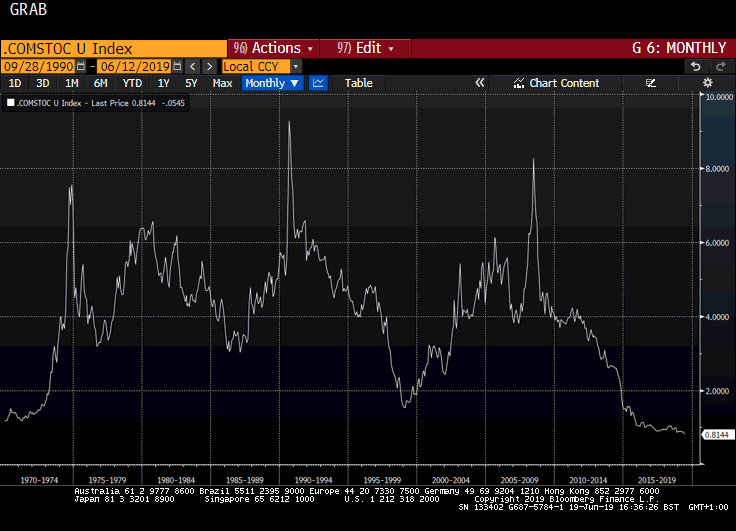
The ratio is created using the S&P GSCI Total Return Index/S&P500.
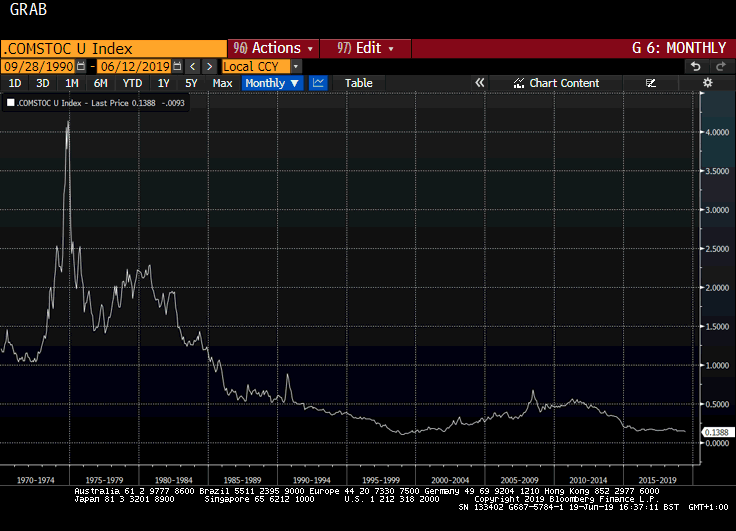
I don’t know what the difference is relative to the S&P GSCI Spot Index but the resulting ratio looks totally different.
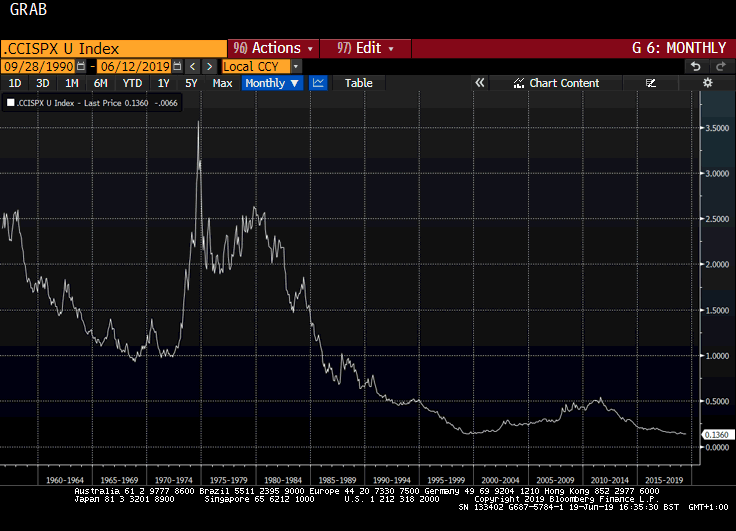
The Continuous Commodity Index / S&P500 looks quite similar but with more back history.
I usually like to compare total return indices on a like for like basis but it is arguable whether this is relevant on commodities since they do not have a yield. However, the large divergence between the total return and spot figures suggests there is a pick-up in the rolls being calculated in the total return index which is creating the more attractive chart.
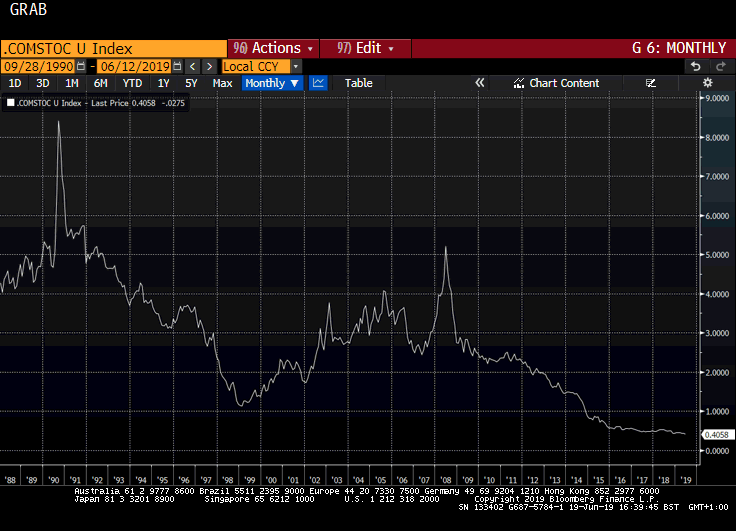
The version with two total return figures also looks totally different.
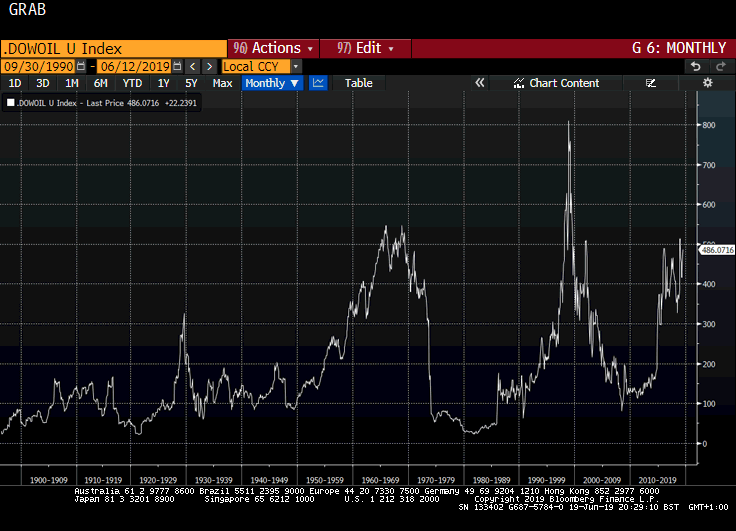
Meanwhile I favour the Dow/Oil ratio because we have lots of back history, both are spot indices and there is clear cyclicality. So, my chart supports my narrative of a secular bear market in energy and the first chart above supports the narrative that commodities are setting up for a major recovery. The secular outlook for energy is a significant determinant in the credibility of the secular bull market hypothesis. So, what conclusions can be drawn?
The first is a ratio depends on a move in one or both variables to change direction. The reliance of the stock market on the performance of mega-cap shares holds out the prospect that when they eventually do roll over the resulting pullback will be enough to move the direction of the ratio. Alternatively, the potential for a geopolitical struggle between the USA, as the newly emerging global swing producer, and incumbents like Russia and Iran, coupled with the trade war with China, has the potential to support oil prices and commodities more generally. Since a spike in commodity prices could be the catalyst for a stock market pullback that is about the only narrative, I can think of that would result in at least a temporary rebound for the ratio.
While the question of geopolitical uncertainty is not far from the headlines at present, oil is still trending downwards. Until that changes there is no urgency to the oil bull argument.
Back to top

